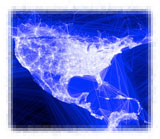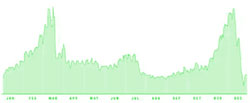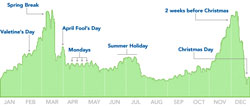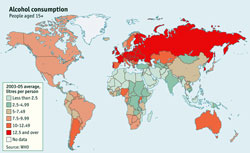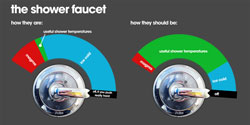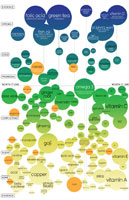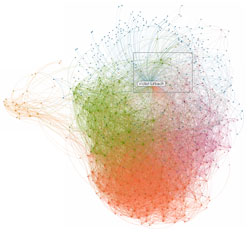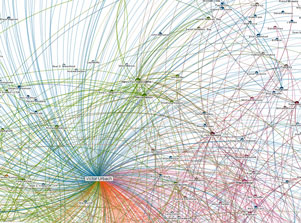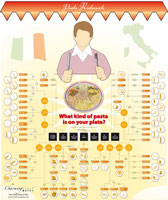|
|
||
Making Sense of the Numbers... with Infographics We're soaking in a data-drenched world. A massive new quantity of information is generated, collected, and distributed every millisecond. Forget about the old "Trying to take a drink from a fire hose" cliché. That's so 2000's. The fire hose is now a broken 18-inch water main... Most of that new information is numerical. That's unfortunate because human beings aren't very good at scanning huge tables of numbers. We see the rows and columns but have a limited ability to form meaningful conclusions from the digits. No surprise there. We Homo sapiens have been around for 200,000 years, but "numbers" are a relatively recent invention. Our primeval skillset revolved around pattern recognition (e.g., being able to spot a prey animal hiding in the bush). That's why graphics are so important. Properly constructed information graphics enable us to understand immense quantities of data at a glance, using our keen ability to interpret colors, shapes, groupings, and patterns. A Social Graph In an August 2010 TEDTalks speech on The Beauty of Data Visualization, info-journalist David McCandless displayed a calendar graph containing 10,000 data points:
He then asked, "Can you guess what this data represents? What rises twice a year, once at Easter and again two weeks before Christmas, has a mini-peak every Monday, and then flattens out during the summer?" The audience guessed chocolate sales, shopping, and sick leave. Nope. This is a chart of peak break-up times according to Facebook status updates! His research team scoured ten thousand facebook status updates for the terms "break-up" and "broken up." Plotting that data on a 12-month axis enables some interesting observations: people tend to break up more often before vacations and holidays. April Fool's Day is big ("Knock-knock." "Who's there?" "Not you anymore!) Mondays are big, probably reflecting on weekend dates gone bad. The freedom-enabling peak before spring break is understandable, while the two weeks before Christmas is most likely gift-buying avoidance. The World's Drinking Habits On February 11, 2011, the World Health Organization published an 85 page document: Global Status Report on Alcohol and Health, presenting volumes of data related to booze consumption in 193 W.H.O. Member States. The bottom line is summarized in this single infographic: The world average consumption is the equivalent of 6.1 liters of pure alcohol per person in the most recently studied year (2005). That middle band is colored tan (parts of China and Africa and South America). Most of the Americas came in above that average (7.5 to 9.99 liters), while Europeans and members of the former Soviet states really tipped it at 12.5 liters or more. Moldovans topped the list, with a per-capita consumption of 18.2 liters. This is a great example of using a color-coded map as an infographic. It "distills" down a huge amount of information to deliver a compelling graphic. Faucet Handle Rotation Versus Perceived Shower Water Temperature Great infographics don't have to be deadly serious. This one's just for fun: However, I show it here as an example to make the point that every graphic should either communicate an idea, persuade the viewer, or present information in unique way. (Entertainment value is a plus.) LOLcats or Breasts – Which Will You Choose to Learn About? Some tall infographics are used to present a graphical story. I've chosen two examples for you. The first explains the origin of LOLcats and several other Internet memes while the second (marginally NSFW) presents some interesting factoids about the female breast:
Even if your topic is interesting, people aren't so keen on reading big blocks of grey text. That's the main driver behind the proliferation of graphically-enhanced narrative material in print and on the web. Is it Good for You or Snake Oil? During David McCandless' TED Talk, David mentioned that he's very interested in health and wellness but was confused by all the claims being made about the efficacy of various supplements and remedies. There's a ton of conflicting data. He therefore created a "balloon race" infographic compiled from over 1,000 studies published in PubMed.gov. The higher up each balloon appears, the larger amount of evidence exists for each supplement, while the size of the balloon corresponds to its "popularity" measured by number of Google hits: When presented this way, it's possible to draw a "Worth it?" line. Any balloon above that line is worth investigating (but only for the condition listed within the circle), whereas the ones below the cutoff line perhaps lack sufficient evidence to bet your health on, no matter how "popular" they are. (By the way, it took two months of work to create the graphic. There is an interactive version that allows you to filter the results now available here.) LinkedIn Relationship Map I've had a LinkedIn account for many years but only recently started to take it seriously. As of this writing I have 702 first-degree contacts... but quantity is not always a good thing. After a certain number, it's hard to keep track of your relationships. Fortunately, there's a new "Maps" application from LinkedIn Labs: You instruct this app to access your LinkedIn account and, after some heavy-duty data crunching, it plots a network graph (I recommend doing it for your own account as it'll be much more meaningful to you than examining mine). On your screen, you'll be able to zoom into the mesh as much as you want to better examine the contacts. Just for an example, I zoomed into the box area marked above to create this next view: Each dot represents a contact of yours. The size of the dot reflects the number of connections that person has, while the color coding is generated from a rather in-depth analysis of your network to determine common factors (not just company or school affiliations for example). The colors will have different meaning for each person's unique LinkedIn map, and it's up to you to provide a legend by observing what various people have in common. As an example, my network contains a very heavy concentration of legal, accounting, and finance professionals. The purplish net centered at 3 o'clock reflects one of those concentrations. The rather sparse blue spray at top is composed of somewhat random people I know who may have their own large networks (or not), but aren't well connected to the other people I know. This is all fascinating to me -- and will be for you too, after you've created your own relationship map... What Kind of Pasta is on Your Plate? Can you tell the difference between conchigliette and funghini? How about fusilli versus gemelli? Penne versus trenne? This is one of those situations where you need a different kind of map: a graphical tree structure that will help you determine the kind of pasta on your plate: Can you imagine how hard it would have been to create this without pictures? It's just one last example of the power of well-executed infographics. I hope this article has started you thinking about how you can better represent your work and interests in a form that's meaningful, accessible, and fun.
|

